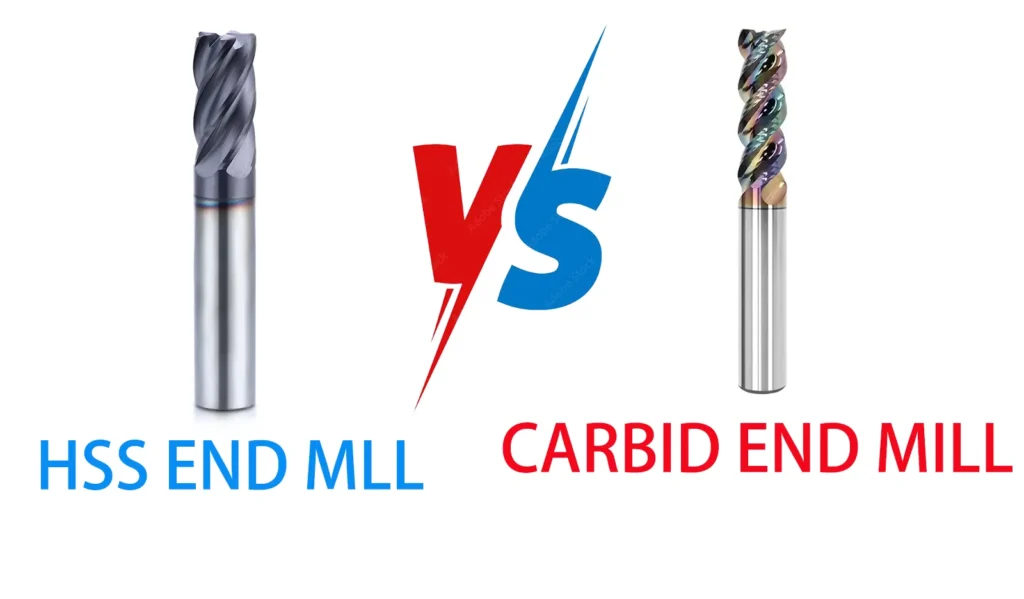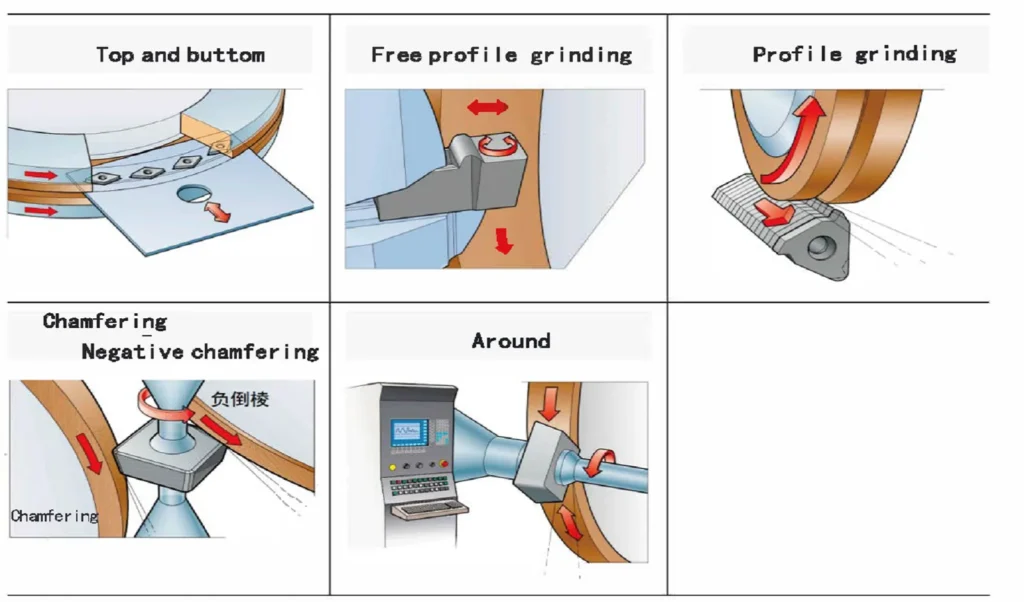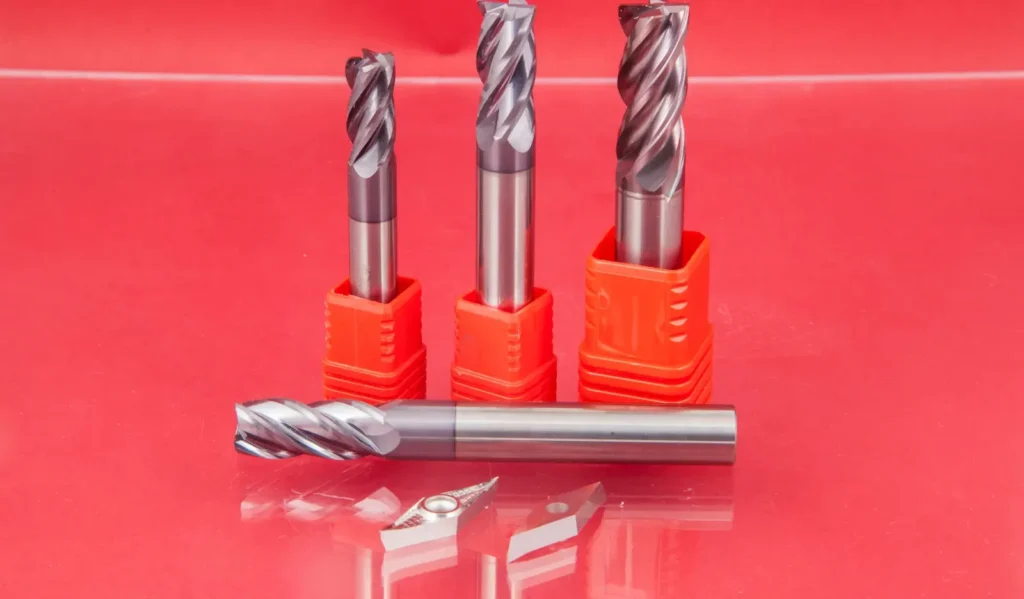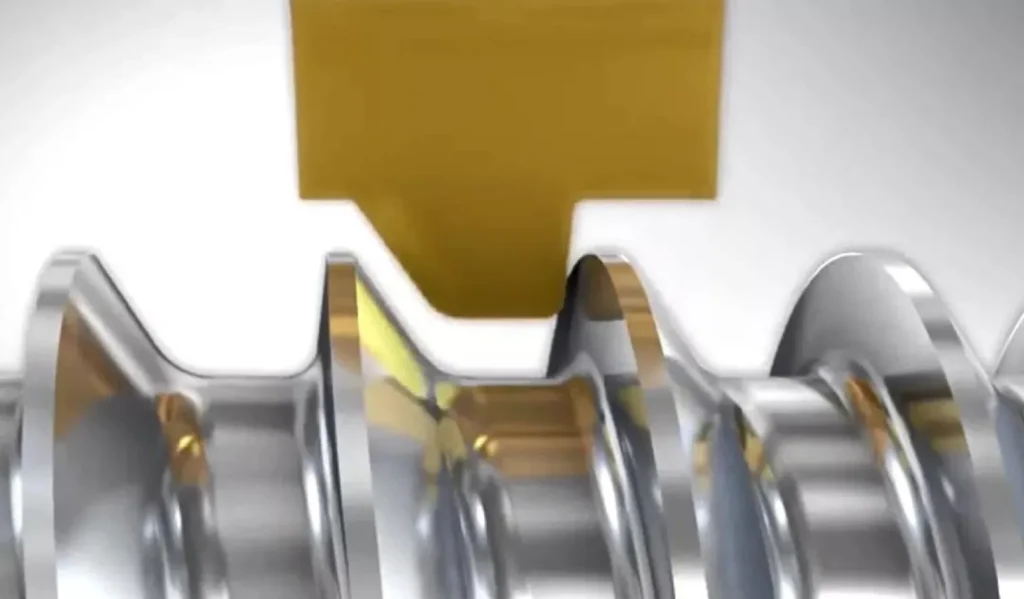機械加工や金属加工の世界では、適切な工具材料を選択することで、生産性、精度、費用対効果が大きく変わります。切削工具に使用される最も一般的な材料は、超硬合金と高速度鋼(HSS)の2つです。それぞれに長所と短所があり、異なる用途に適しています。この包括的なガイドでは、さまざまな用途における超硬工具とハイス工具の違いについて説明し、特定のニーズに対して十分な情報に基づいた決定を下せるよう支援します。
ハイスと超硬の比較

具体的な工具の種類に入る前に、超硬合金とハイスの基本的な特性を理解することが不可欠です。
超硬合金は、超硬合金または炭化タングステンとも呼ばれ、炭化タングステン粒子を金属バインダー(通常はコバルト)で結合した複合材料です。非常に硬く、耐摩耗性に優れ、高温でも鋭い切れ刃を維持できることで知られています。
高速度鋼(HSS)は、タングステン、モリブデン、バナジウム、クロムを多量に含む合金鋼である。硬度と靭性に優れ、標準的な炭素鋼よりも高い切削温度に耐えることができる。
一般的に、超硬合金はハイスよりも硬く耐摩耗性に優れているため、切削速度の高速化と工具寿命の延長が可能です。しかし、ハイスはより硬く、脆くないため、衝撃や振動に強い。また、一般的にハイス工具は超硬工具よりも安価です。
超硬タップとハイスタップの比較
タッピング作業に関しては、超硬とハイスのどちらにも適材適所がある。
超硬タップの利点
- 切断速度が向上し、生産性が向上
- 優れた耐摩耗性により、工具寿命が長くなる
- より硬い素材での優れた性能
- 特定の用途におけるスレッド品質の向上
超硬タップの欠点
- ハイスタップより高価
- よりもろく、適切に使用しないと破損しやすい。
- チッピングを防止するため、より剛性の高いマシン・セットアップが必要。
ハイスタップの利点
- 剛性の低いセットアップに寛容
- コストが低いため、少量生産でも経済的
- 再研磨が容易で、使用寿命が延びる
- より柔らかく、グミのような素材でより優れた性能を発揮
ハイスタップの欠点
- 超硬と比較して低い切削速度
- 研磨材での工具寿命の短縮
- 非常に硬い素材に苦戦する可能性がある
ベストアプリケーション
- 大量生産、より硬い素材(35HRC以上)、優れたねじ品質が重要な場合は、超硬タップを使用する。
- 一般的なタッピング、より軟らかい材料、機械の剛性が問題になる場合は、ハイスタップを選択する。
超硬ドリルとハイスドリルの比較
ドリルビットは多くの機械加工に不可欠であり、超硬とハイスの選択は性能に大きな影響を与えます。
超硬ドリルビット
- 高い切削速度と送り速度を提供
- 特に研磨材において、より長い工具寿命を実現
- より良い穴精度と表面仕上げを維持
- より硬い材料の穴あけ加工に威力を発揮
HSSドリルビット
- 少量生産により経済的
- 脆くなりにくく、不安定な状況下での破損リスクを低減する。
- 研ぎ直しが容易で、何度も研ぎ直せる。
- 幅広い一般的な素材で優れた性能を発揮する
コストに関する考察
超硬ドリルビットは一般的に初期費用は高いが、寿命が長く生産性が高いため、大量生産では費用対効果が高くなる。HSSビットは、時折使用する場合や小規模な店舗では、より予算に適しています。
適した素材と用途
- 特に大量生産では、硬質金属、複合材料、研磨材用の超硬ドリルビットを使用する。
- 軟質金属、木材、プラスチックの汎用ドリル加工、特に少量加工や多様な用途には、HSSドリルビットを選択する。
超硬エンドミルとハイスエンドミル
エンドミルは、フライス加工に使用される汎用性の高い切削工具で、超硬とハイスの選択は加工効率に大きく影響します。
切削速度と送り速度
超硬エンドミル は、ハイスと比較して、大幅に高い切削速度と送り速度で加工できます。これは、より速い材料除去と生産性の向上につながります。
工具寿命と耐摩耗性
超硬エンドミルは一般的に耐摩耗性に優れ、特に硬い被削材ではハイスエンドミルよりも切れ刃を長く維持します。しかし、ハイスエンドミルの方が衝撃に強く、加工条件が安定しない場合には、より寛容に対応できます。
加工精度と表面仕上げ
超硬エンドミルは、その剛性とたわみにくさにより、一般的に優れた仕上げ面精度を実現し、より厳しい公差を維持します。ハイスエンドミルは、同等の仕上げ面を得るために、低速回転が必要になる場合があります。
超硬とハイスの旋盤用工具
旋盤工具は旋盤加工に欠かせないもので、超硬とハイスのどちらを選ぶかは様々な要因によって決まる。
様々な材料に対する切削性能
超硬旋盤工具 は、より硬い被削材の加工に優れ、高速加工でも安定した性能を維持します。HSS 工具は、より汎用性が高く、軟質から中硬度の幅広い被削材で優れた性能を発揮します。
耐熱性と冷却要件
超硬工具は、より高い切削温度に耐えることができるため、多くの場合、ドライ加工やクーラントの使用量を減らすことができる。一般的に、ハイス工具は切れ刃を維持するために、より多くの冷却を必要とする。
工具の形状と多様性
ハイス旋盤用工具は、複雑な形状に簡単に研削できるため、カスタムプロファイル加工に多用途に使用できる。超硬工具は、あらかじめ定義された形状のチップ状で提供されることが多く、素早く変更することができるが、カスタマイズ性は低い。
超硬鉋刃とハイス鉋刃の比較
木工では、超硬プレーナー刃とハイスプレーナー刃の選択は、作業の質と効率に影響します。
エッジの保持とシャープネス
超硬カンナ刃は、特に硬い木材や複合材を加工する場合、ハイスよりはるかに長く切れ味を維持します。HSS刃は、より頻繁に研ぐ必要がありますが、非常に鋭い刃先を得ることができます。
耐衝撃性と耐久性
HSSカンナ刃は一般に、木の節や異物による衝撃に強い。超硬刃は硬いですが、もろく、金属や石にぶつかると欠けることがあります。
さまざまな木工ニーズに対応する費用対効果
ホビーユーザーやたまにしか使わないユーザーにとって、ハイスブレードは性能と価格のバランスが取れています。プロの木工家やエキゾチックな広葉樹を扱う人には、超硬ブレードの長寿命と安定した性能が、高い初期費用を正当化するかもしれません。
木工旋盤用超硬工具とハイス工具の比較
木工旋盤には、木を削るという独特の課題に対応できる道具が必要だ。
さまざまな木材の旋削性能
超硬木工旋盤用工具は、より硬い木材を旋削し、安定した刃先を維持するのに優れています。HSS工具はより汎用性が高く、様々な木材の種類や旋削技術に対応できるよう、簡単に研ぐことができます。
研ぎやすさとメンテナンス
ハイス製木工旋盤用工具は、ベンチグラインダーや研ぎ石で素早く仕上げられるので、使用中に頻繁に研ぎ直すことができる。超硬工具は、多くの場合、交換可能なチップを使用しているため、研ぐ必要はないが、鈍い場合は交換が必要である。
長期的価値と投資
超硬木工旋盤用工具は初期費用が高いが、寿命が長く、安定した性能を発揮するため、本格的な木工旋盤加工を行う人にとっては、価値ある投資となる。ハイス工具は初期費用が安く、初心者や工具のメンテナンスの過程を楽しみたい人に適している。
ハイス対コバルト対超硬
切削工具の材料を考えるとき、標準的なハイスや超硬に代わるものとしてコバルト鋼を挙げる価値がある。
硬度と耐摩耗性の比較
超硬が最も硬く耐摩耗性に優れ、次いでコバルト鋼で、ハイスは3種の中で最も軟らかい。このため、特に要求の厳しい用途では、超硬工具の刃先保持力が長くなる。
耐熱性と切断速度
超硬工具は、最も高い切削温度に耐えることができ、最も速い切削速度を可能にする。コバルト鋼は、標準的なハイスよりも耐熱性が向上しており、中間の切削速度に適している。
コストとパフォーマンスのトレードオフ
ハイス工具は最も経済的だが、交換頻度が高くなる可能性がある。コバルト鋼工具は、超硬よりも低コストで、ハイスよりも性能が向上する中間的な製品である。超硬工具は最も高価だが、大量生産または要求の厳しい用途では、長期的に最高の価値を提供することが多い。
結論
超硬工具とハイス工具のどちらを選ぶかは、お客様の加工ニーズ、予算、長期的な目標を慎重に考慮する必要があります。一般的に、超硬工具は硬度、耐摩耗性、切削速度に優れていますが、ハイス工具は多くの用途で汎用性、耐衝撃性、費用対効果を発揮します。
選択の際に考慮すべき主な要素は以下の通り:
- 加工材料
- 生産量
- 機械の性能と剛性 初期予算と長期的コストの比較
- 要求される表面仕上げと公差
- オペレーターのスキルレベルと好み
加工技術が進歩し続けるにつれ、超硬工具とハイス工具の配合がさらに改良されることが予想される。さらに、新しいコーティング技術やハイブリッド材料の開発により、この2つの強力な工具オプションの境界線がさらに曖昧になるかもしれません。
結局のところ、最善の選択は、特定の用途に適した性能とコストのバランスを見つけることにかかっています。超硬工具とハイス工具の長所と短所を理解することで、加工プロセスを最適化し、全体的な生産性を向上させるために、十分な情報に基づいた決定を下すことができます。
ハイスと超硬の違いは何ですか?
高速度鋼は主に鉄に炭化物形成合金元素を添加したもので、炭化タングステンは主に炭化タングステン粒子にコバルトを結合させたものである。高速度鋼は熱間硬度に優れ、超硬合金は硬度と耐摩耗性に優れています。
ハイスとタングステンカーバイドの異なる用途分野とは?
ハイスは、ドリル、エンドミルなどの切削工具によく使用される。超硬合金は、旋削、フライス加工、リーマ加工などの連続切削や断続切削の工具によく使用される。
ハイスと超硬それぞれの長所と短所は?
ハイスの長所は、安価で加工性が良いことであるが、短所は、硬度と耐摩耗性が劣ることである。タングステンカーバイドの長所は高硬度と耐摩耗性ですが、短所は高コストと脆さです。
機械加工におけるハイスと超硬合金の切削速度の比較は?
同じ切削条件であれば、超硬合金は高速度鋼の3~5倍の切削速度が得られます。
ハイス工具と超硬工具の工具寿命の違いは何ですか?
同じ切削条件であれば、超硬工具は高速度鋼工具に比べて数倍から数十倍の工具寿命を持つ。



